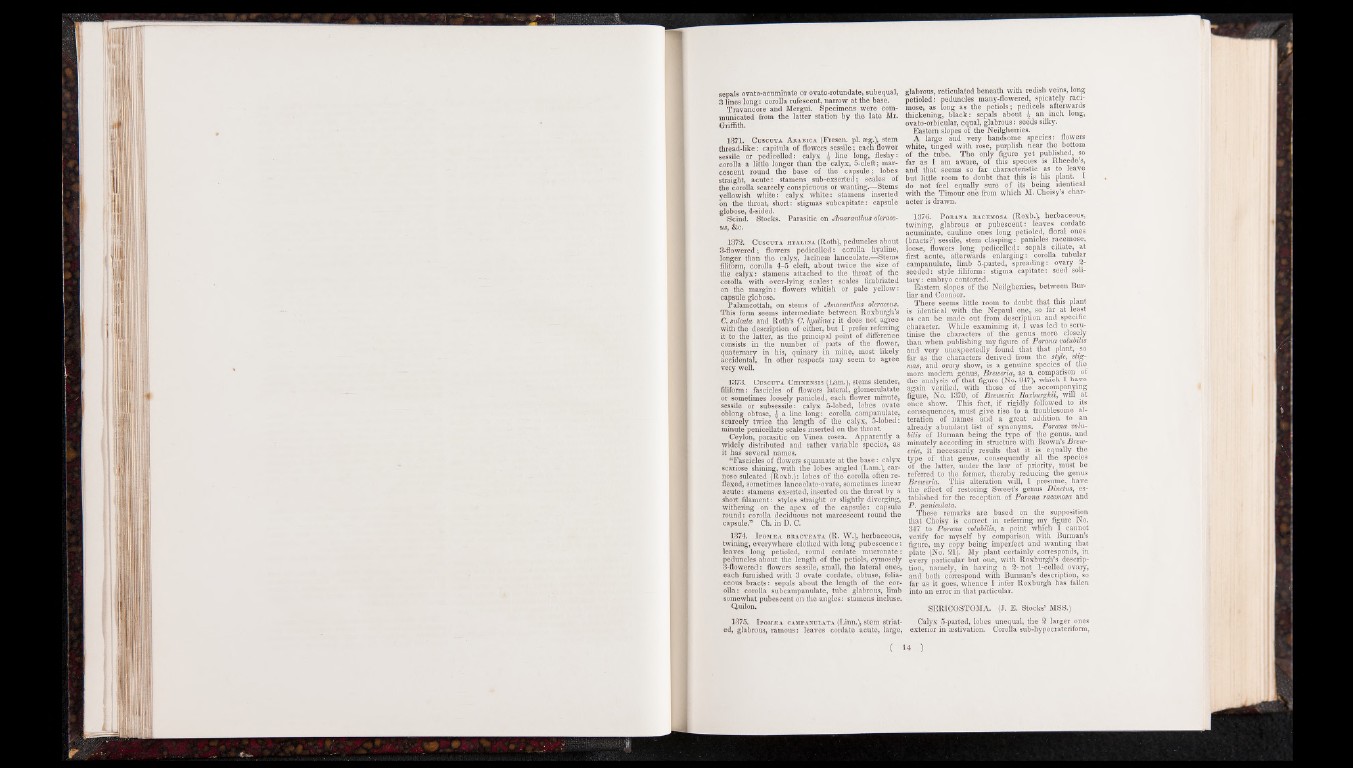
sepals ovato-acuminate or ovato-rotundate, subequal,
3 lines long: corolla rufescent, narrow at the base.
Travancore and Mergui. Specimens were communicated
from the latter station by the late Mr.
Griffith.
1371. Cdscxjta Arabica (Fresen. pi. aeg.), stem
thread-like: capitula of flowers sessile; each flower
sessile or pedicelled: calyx | line long, fleshy:
corolla a little longer than the calyx, 5-cleft; mar-
cescent round the base of the capsule; lobes
straight, acute: stamens sub-exserted; scales of
the corolla scarcely conspicuous or wanting.—Stems
yellowish white: calyx white: stamens inserted
on the throat, short: stigmas sub capitate: capsule
globose, 4-sided.
Scind. Stocks. Parasitic on Amaranthus olerace-
us, &c.
1373. Cuscuta htalina (Roth), peduncles about
3-flowered; flowers pedicelled: corolla hyaline,
longer than the calyx, lacineae lanceolate.—Stems
filiform, corolla 4 -5 cleft, about twice the size of
the calyx: stamens attached to the throat of the
corolla with over-lying scales: scales fimbriated
on the margin: flowers whitish or pale yellow:
capsule globose.
Palamcottah, on stems of Amaranthus oleraceus.
This form seems intermediate between Roxburgh’s
C. sulcata and Roth’s C. hy alina; it does not agree
with the description of eitner, but I prefer referring
it to the latter, as the principal point of difference
consists in the number of parts of the flower,
quaternary in his, quinary in mine, most likely
accidental. In other respects may seem to agree
very well.
1373. Cuscuta Chinensis (Lam.), stems slender,
filiform: fascicles of flowers lateral, glomerulatate
or sometimes loosely panicled, each flower minute,
sessile or subsessile: calyx 5-lobed, lobes ovate
oblong obtuse, ^ a line long: corolla campanulate,
scarcely twice the length of the calyx, 5-lobed:
minute penicellate scales inserted on the throat.
Ceylon, parasitic on Vinea rosea. Apparently a
widely distributed and rather variable species, as
it has several names.
“Fascicles of flowers squamate at the base: calyx
scariose shining, with the lobes angled (Lam.), car-
noso sulcated (Roxb.): lobes of the corolla often reflexed,
sometimes lanceolato-ovate, sometimes linear
acute: stamens exserted, inserted on the throat by a
short filament: styles straight or slightly diverging,
withering on the apex of the capsule: capsule
round: corolla deciduous not marcescent round the
capsule.” Ch. in D. C.
1374. IpoMjEa bracteata (R. W.), herbaceous,
twining, everywhere clothed with long pubescence:
leaves long petioled, round cordate mucronate:
peduncles about the length of the petiols, cymosely
3-flowered: flowers sessile, small, the lateral ones,
each furnished with 3 ovate cordate, obtuse, folia-
ceous bracts: sepals about the length of the corolla:
corolla subcampanulate, tube glabrous, limb
somewhat pubescent on the angles: stamens incluse.
Quilon.
1375. Ipomjea campanulata (Linn.), stem striated,
glabrous, ramous: leaves cordate acute, large,
glabrous, reticulated beneath with redish veins, long
petioled: peduncles many-flowered, spicately raci-
mose, as long as the petiols; pedicels afterwards
thickening, black: sepals about ^ an inch long,
ovato-orbicular, equal, glabrous: seeds silky.
Eastern slopes of the Neilgherries.
A large and very handsome species: flowers
white, tinged with rose, purplish near the bottom
of the tube. The only figure yet published, so
far as I am aware, o f this species is Rheede’s,
and that seems so far characteristic as to leave
but little room to doubt that this is his plant. I
do not feel equally sure of its being identical
with the Timour one from which M. Choisy’s character
is drawn.
1376. P orana racemosa (Roxb.), herbaceous,
twining, glabrous or pubescent: leaves cordate
acuminate, cauline ones long petioled, floral ones
(bracts?) sessile, stem clasping: panicles racemose,
loose, flowers long pedicelled: sepals ciliate, at
first acute, afterwards enlarging: corolla tubular
campanulate, limb 5-parted, spreading: ovary 2-
seeded: style filiform: stigma capitate: seed solitary:
embryo contorted.
Eastern slopes of the Neilgherries, between Bur-
liar and Coonoor.
There seems little room to doubt that this plant
is identical with the Nepaul one, so far at least
as can be made out from description and specific
character. While examining it, I was led to scrutinise
the characters of the genus more closely
than when publishing my figure of Porana volubilis
and very unexpectedly found that that plant, so
far as the characters derived from the style, stigmas,
and ovary show, is a genuine species of the
more modem genus, Breweria, as a comparison of
the analysis of that figure (No. 347), which I have
again verified, with those of the accompanying
figure, No. 1370, of Breweria Roxburghii, will at
once show. Thus fact, if rigidly followed to its
consequences, must give rise to a troublesome alteration
of names and a great addition to an
already abundant list of synonyms. Porana volu-
bilis of Burman being the type of the genus, and
minutely according in structure with Brown’s Breweria,
it necessarily results that it is equally the
type of that genus, consequently all the species
of the latter, under the law of priority, must be
referred to the former, thereby reducing the genus
Breweria. This alteration will, I presume, have
the effect of restoring Sweet’s genus Dinetus, established
for the reception of Porana racemosa and
P . paniculata.
These remarks are based on the supposition
that Choisy is correct in referring my figure No.
347 to Porana volubilis, a point which I cannot
verify for myself by comparison with Burman’s
figure, my copy being imperfect and wanting that
plate (No. 21). My plant certainly corresponds, in
every particular but one, with Roxburgh’s description,
namely, in having a 2- not 1-celled ovary,
and both correspond with Burman’s description, so
far as it goes, whence I infer Roxburgh has fallen
into an error in that particular.
SERICOSTOMA. (J. E. Stocks’ MSS.)
Calyx 5-parted, lobes unequal, the 2 larger ones
exterior in aestivation. Corolla sub-hypocrateriform,
( )